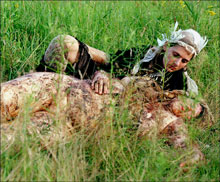 Summer is when our art museums typically turn out their great modern Maine artists — Homers, Wyeths, and other well-known masters who made this seaswept land their home, at least in the summer — to make the most of the tourist migration. This weekend the Bates College Museum of Art shall make the rest of the Maine Art Museum Trail scratch its head in wonderment when it unveils the cryptozoological community’s most highly esteemed artworks by a Wyeth family member, living or otherwise: Jamie Wyeth’s “Study for Antubis I” and “Study for Antubis II.”
Summer is when our art museums typically turn out their great modern Maine artists — Homers, Wyeths, and other well-known masters who made this seaswept land their home, at least in the summer — to make the most of the tourist migration. This weekend the Bates College Museum of Art shall make the rest of the Maine Art Museum Trail scratch its head in wonderment when it unveils the cryptozoological community’s most highly esteemed artworks by a Wyeth family member, living or otherwise: Jamie Wyeth’s “Study for Antubis I” and “Study for Antubis II.”
It’s not his most famous series — let’s just say you won’t see a thumbnail of it on his 77th Street gallery’s artist’s page — but this pair, produced as designs for Stephen King’s television series Kingdom Hospital, may turn out to be his most consequential.
Bernard Heuvelmans, whose On the Track of Unknown Animals is one of the seminal texts in the field of cryptozoology, wrote that because cryptozoological research demands “a thorough grasp of most of the zoological sciences” as well as “training in such extraneous branches of knowledge as mythology, linguistics, archaeology and history,” much of cryptozoology happens “in libraries, newspaper morgues, regional archives, museums, art galleries, laboratories, and zoological parks rather than in the field!”
If a cryptozoologist can practice cryptozoology in a museum or an art gallery and consider her activities to be part of scientific inquiry, is it fair to consider an artist conducting research in the territory of cryptozoology (which is itself, as Heuvelmans characterized it, an assemblage of zoological sciences, human sciences, and humanities disciplines) to be conducting a scientific inquiry as well?
Indeed both of these endeavors, cryptozoologist/artist tracking her cryptids from art to science and back again, represent that sort of genuine interdisciplinarity that Roland Barthes had in mind when he spoke of that rare practice that results in the production of an object of inquiry that belongs to no one. Philosopher and cultural critic Theodor Adorno wrote that “it is immoral to feel at home in one’s home.” It’s the same idea, just expressed in the Germanic. To work in this way requires of the properly interdisciplinary practitioner not some kind of multiple expertise in several fields, however helpful that might be, but rather the willingness to perform the unheimlich maneuver: the self-imposed and self-invited exile of oneself and one’s work from the condition of being at home, the willingness to throw oneself and one’s work into a language that one will never master but which might, if you are lucky, learn to love you despite your foreignness.
This is the territory that “Out of Time Place Scale” wanders through, certain of nothing other than the promise of the investigation it helps to create.